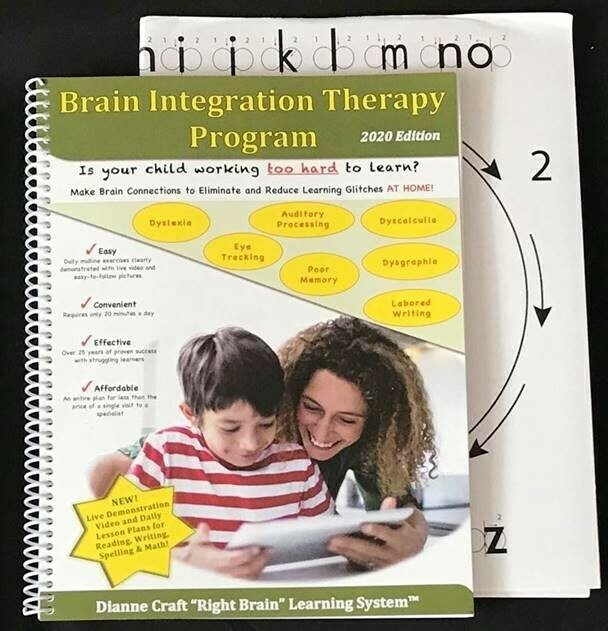Brain Integration Therapy Manual
Why Brain Integration Therapy?
When a new task is learned, such as riding a bike, driving a car, learning to track the eyes from left to right in reading, or learning the orientation of letters or numbers, the left, concentrating brain hemisphere is engaged. After a short time of practice, these processes should transfer into the child's right brain to be stored in the automatic hemisphere so he or she can now think and track his or her eyes at the same time, think and write at the same time, think an hear sounds at the same time, etc.
When this transfer isn’t easily made between brain hemispheres, the child becomes overwhelmed with the learning task and begins to get behind in reading and writing because of the effort involved in a process that should take very little effort if both brain hemispheres were involved. This can appear as dyslexia, dysgraphia, or more mild processing problems in reading, writing, and hearing.
These hemispheric connections, which appear to be absent or “disconnected” can be encouraged to reconnect by using specific body exercises that cross the mid-line of the body. When these short, daily exercises are combined with the more powerful once-a-week Brain Training, these vital connections are slowly, progressively made each week. By using this process, parents and teachers see the learning process (elimination of visual and writing reversals, remembering phonics sounds, etc.) become easier after just a few weeks. However, it is important to continue this process for at least 3-9 months, so that the gains are not lost.
The Brain Integration Therapy Manual, by Dianne Craft, MA, CNHP, includes:
- Detailed diagnostic checklists for each of the processing problem areas a child could be experiencing:
- Visual Processing Problems (reading reversals, eye convergence and eye tracking issues, tires easily when reading)
- Writing/Fine Motor processing problems (greatly labored writing, dysgraphia, fine motor issues, child who is “allergic” to a pencil)
- Auditory Processing problems (can’t remember phonics, sight words hard, oral directions difficult, scrambles words when saying them, etc.)
- Pictures of children demonstrating every single step of the all-important once a week Brain Training session, and the daily 20-minute exercise routine. This is easy to follow!
- Examples of each of the 10 Auditory Processing “channels” that can be blocked in a child, and how to correct these blocks. Comes with charts to help you diagnose and help you track your child’s progress.
- Case studies of children who have just one learning gate blocked, two learning gates blocked, three learning gates blocked, or all four learning gates blocked. This will make it easier for you to see where your child’s issues are, and what to do about them.
- A diagnostic reading grade-placement test that we give at the beginning of this process, and then ever 3 months, to track the child's progress in reading as we do this therapy.
- Daily Lesson plans for a struggling Reader, Writer, and Speller. These lesson plans are invaluable in your work with a struggling child. They give the daily routine using Brain Integration Therapy to remove learning glitches, along with the Right Brain teaching strategies used to bypass the learning glitches in a child. These are the very lesson plans that Dianne Craft used in her Resource Room to achieve the two-year growth in reading and writing in a year. The Right Brain teaching strategies help a child feel smart right away (using their photographic memory strength), while the Brain Integration Brain Training done once a week, eventually makes enough pathways connecting both brain hemispheres that the child will not need Right Brain teaching strategies all of his life.

